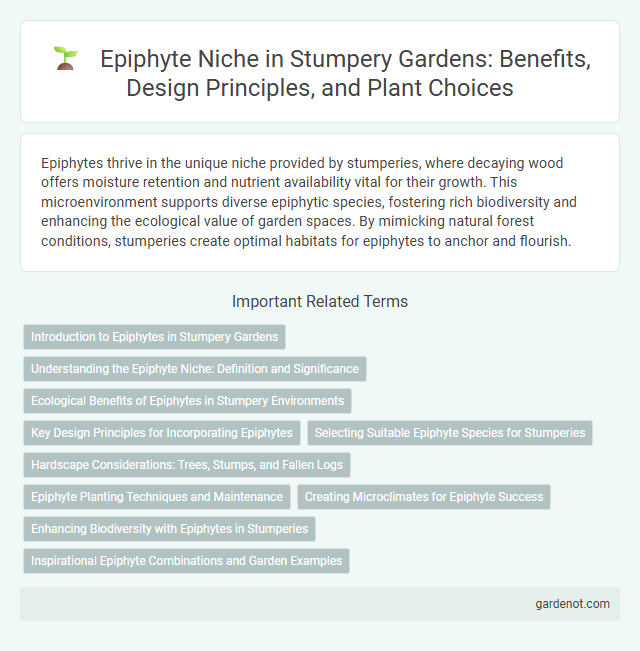Epiphytes thrive in the unique niche provided by stumperies, where decaying wood offers moisture retention and nutrient availability vital for their growth. This microenvironment supports diverse epiphytic species, fostering rich biodiversity and enhancing the ecological value of garden spaces. By mimicking natural forest conditions, stumperies create optimal habitats for epiphytes to anchor and flourish.
Introduction to Epiphytes in Stumpery Gardens
Epiphytes are non-parasitic plants that grow on other plants or structures, thriving in the humid microclimate of stumpery gardens. These plants, including orchids, ferns, and bromeliads, utilize moss-covered wood and decaying tree stumps as natural supports, enhancing biodiversity and visual interest. Their unique adaptation to absorb moisture and nutrients from the air and surrounding debris makes epiphytes essential to the ecological balance within stumpery displays.
Understanding the Epiphyte Niche: Definition and Significance
The epiphyte niche refers to the specialized habitat where epiphytes grow non-parasitically on other plants, primarily tree branches and trunks, deriving moisture and nutrients from the air and rain. This niche is significant for biodiversity, as epiphytes play key roles in forest canopy ecosystems by providing habitat and food sources while contributing to nutrient cycling. Understanding the epiphyte niche aids in conservation efforts and informs ecological research on plant adaptation and symbiotic relationships.
Ecological Benefits of Epiphytes in Stumpery Environments
Epiphytes in stumpery environments create critical microhabitats that support biodiversity by providing shelter and food sources for various invertebrates and small animals. Their ability to capture moisture and nutrients from the air enhances local humidity and nutrient cycling, contributing to overall ecosystem health. These plants also reduce soil erosion by stabilizing decaying wood structures, promoting forest regeneration within stumpery landscapes.
Key Design Principles for Incorporating Epiphytes
Designing a stumpery with an epiphyte niche requires maximizing airflow and light exposure to mimic natural canopy conditions vital for epiphytes like orchids and bromeliads. Utilizing decayed wood structures provides the porous, moisture-retentive substrate essential for epiphyte root anchorage and moisture absorption. Strategic placement in shaded or filtered light zones ensures protection from direct sun while maintaining humidity, fostering optimal growth environments for diverse epiphyte species.
Selecting Suitable Epiphyte Species for Stumperies
Selecting suitable epiphyte species for stumperies involves prioritizing plants that thrive in humid, shaded environments and can securely anchor to textured wood surfaces. Common epiphytes such as Tillandsia, Spanish moss (Tillandsia usneoides), and certain orchids exhibit excellent adaptability to stumpery conditions due to their minimal soil requirements and aerial root systems. Ensuring species compatibility with local climate and moisture levels enhances growth success and contributes to a vibrant, sustainable stumpery ecosystem.
Hardscape Considerations: Trees, Stumps, and Fallen Logs
Hardscape elements such as trees, stumps, and fallen logs create ideal niches for epiphytes in a stumpery environment by providing stable surfaces for attachment and growth. These features retain moisture and organic matter, fostering microhabitats essential for epiphytes like ferns, mosses, and orchids. Strategic placement of these hardscape components enhances biodiversity and mimics natural forest ecosystems, promoting healthy epiphyte communities.
Epiphyte Planting Techniques and Maintenance
Epiphyte planting techniques focus on creating optimal moisture retention and airflow by using porous substrates such as sphagnum moss, orchid bark, and charcoal. Regular misting and humidity control are essential to mimic natural epiphyte habitats, while avoiding waterlogged roots to prevent rot. Maintenance involves periodic inspection for pests, trimming dead material, and adjusting placement to ensure adequate light exposure without direct sunlight.
Creating Microclimates for Epiphyte Success
Stumperies provide ideal microclimates for epiphytes by maintaining high humidity and stable temperatures within decaying wood structures. These shaded, moisture-retentive environments mimic natural epiphyte habitats, promoting healthy growth and reducing water stress. The textured surfaces of stumperies offer secure anchorage, enabling epiphytes to thrive in urban and garden settings.
Enhancing Biodiversity with Epiphytes in Stumperies
Epiphytes play a crucial role in enhancing biodiversity within stumperies by providing unique microhabitats on decaying wood surfaces. Their ability to absorb moisture and nutrients from the air supports diverse insect populations and beneficial microorganisms. Incorporating epiphytes such as mosses, ferns, and orchids enriches the ecological complexity and resilience of stumpery ecosystems.
Inspirational Epiphyte Combinations and Garden Examples
Inspirational epiphyte combinations showcase ferns, orchids, and bromeliads thriving together in shaded, humid environments, creating lush, multi-textured displays. Garden examples highlight epiphytes mounted on driftwood or tree stumps, enhancing vertical spaces with natural elegance and biodiversity. These designs emphasize microhabitats that support moisture retention and air circulation, vital for epiphyte health and growth.
Epiphyte niche Infographic

 gardenot.com
gardenot.com